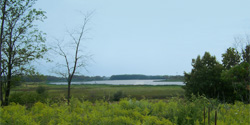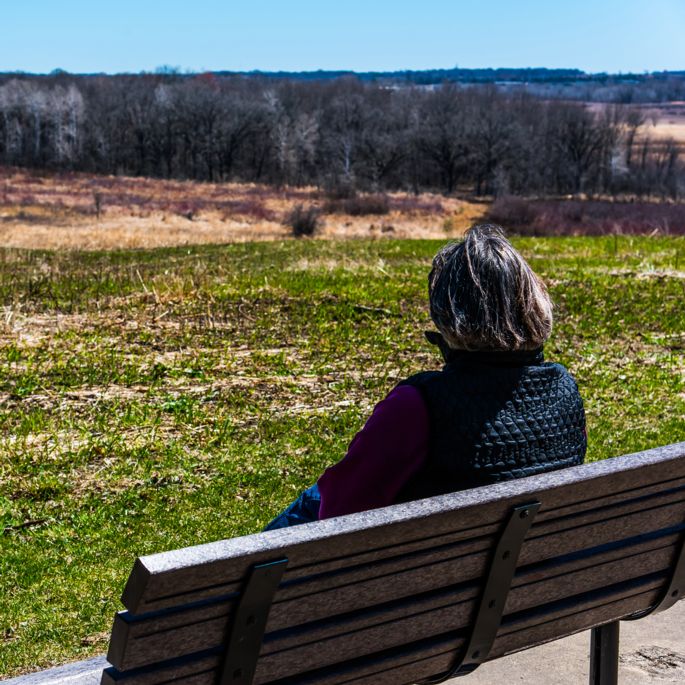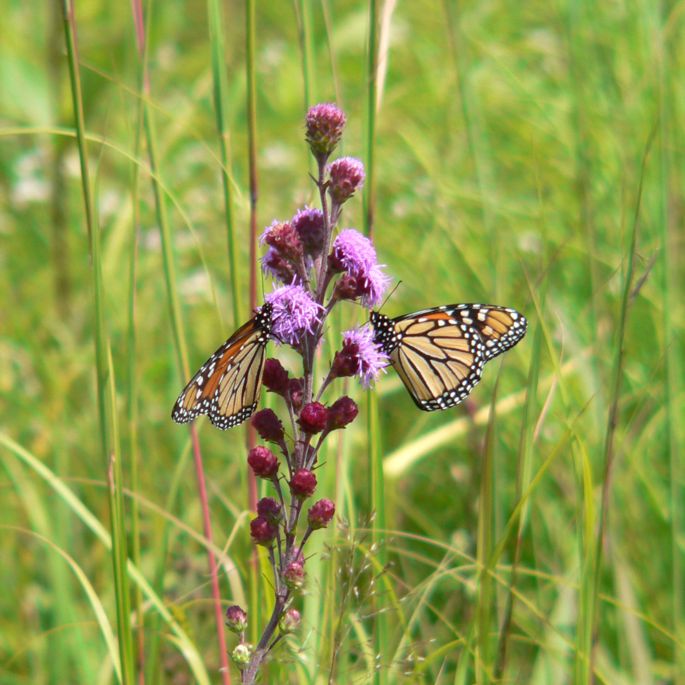Cherokee Marsh Conservation Park - North

| Address: | 6098 N. Sherman Ave. |
| Hours: | 4:00am - dusk |
| Park Type: | Conservation |
| Acres: | 946.58 |
| Restroom: | Yes |
| Drinking Water: | Yes |
| Shoreline On: | Yahara River |
Park Details
Cherokee Marsh Conservation Park, North Unit has trails that explore restored prairie, oak savanna, and woodland. Boardwalks with observation decks offer views of the upper Yahara River, deep marsh, and sedge meadow. A pier provides canoe/kayak access (1/4 mile carry-in from the parking area).

Birdlife includes nesting sandhill cranes in the wetlands and bald eagle and osprey on the river. The wooded areas and woodland edges have scarlet tanager, indigo bunting, rose-breasted grosbeak and woodpeckers. Eastern bluebird and tree swallow nest in the prairie. In spring, American woodcock perform their "sky dance" over the wetlands. Wood-warblers use the area as a migration stop.
This park is a major destination for local residents and environmental education groups.
Visit the Friends of Cherokee Marsh, to learn more including events and volunteer projects.
Park Highlights
- 4.1 miles of trails.

Photo by Jan Axelson - Year-round open restrooms.
- Bird & Nature Adventures: Explore this park with a free, volunteer-led, guided nature walk offered monthly and year-round.
Land Management
Cherokee Marsh, Dane County's largest wetland, is located at the head of the chain of Yahara lakes. Cherokee Marsh - North Unit is one piece in a complex of protected land that supports diverse wildlife and native plant communities in the marsh and adjacent uplands.The park is situated on ancestral Ho-Chunk land. Within the park are two conical mounds constructed by Native Americans before European settlement. Cherokee Marsh's name dates to a 19th-century hunting club in the area.
The first land acquisition for the park occurred in 1964 with numerous additions in the years following. Cherokee Marsh – North Unit was designated a conservation park in 1971 when the Parks Division first created the Conservation Park program.
Previously, agriculture was the dominant land use on the uplands and in more accessible portions of the wetlands, many of which were drained. Major restoration has included filling ditches to restore wetlands, converting old fields to tallgrass prairie, removing invasive woody species from oak woodlands, and prescribed burning.
American lotus has been established in the river to protect the river shoreline from erosion and improve water quality. Restoration of oak woodland and oak savanna has resulted in increased numbers of woodpeckers, including the red-headed woodpecker, a Wisconsin Species of Special Concern. Parks management follows a snag protection policy to preserve dead, standing trees for wildlife.
Burial Mound Policy
Created with assistance from the Wisconsin Historical Society and the Ho-Chunk Nation, and approved by the Board of Park Commissioners in October 2019, the policy provides guidelines and procedures for managing burial mounds located in Madison Parks. Burial mound locations are also included in the policy.
At this Park
-
 Dog Free Park
Dog Free Park
Leashed and licensed dogs are allowed in all general Madison parks. There are a few notable exceptions as detailed in MGO 8.195 and highlighted on this page.
- All dogs must be licensed.
- All dogs must have a valid daily or annual Dog Permit.
- All owners must pick up their dog's waste.
- All dogs must be leashed and under the owner's control at all times. MGO 23.32(1)
- Violators may see a fine up to $500
- Violators may see a fine up to $500
Dog Prohibited Areas
(See MGO 8.195)- Conservation parks
- Burial mounds within 20 feet
- City of Madison Golf Courses (during the golf season)
- Olbrich Botanical Gardens
- Playgrounds and areas within 20 feet of a playground surface
- Splash parks, fenced areas(s) surrounding a splash park, and areas within 20 feet of the splash park surface
- Goodman Pool and Breese Stevens Field (except for special events where dogs are specifically invited)
- Programmed sports fields and facilities that are enclosed or substantially enclosed by a fence, whether in use or not
- Programmed, non-fenced sports fields such as soccer, ultimate fields or softball/baseball diamonds while they are in use for programmed activities
- Inside park shelters or other City buildings
- Groomed cross-country ski trails
- In the water or on the beach at designated beach locations
- Park special events except where the sponsor has requested to allow dogs, with the Park Superintendent's approval
-
Cherokee Marsh Conservation Park - North - Dog Free Park
Location: 6098 N. Sherman Ave.
-
 Fishing
Madison Parks offers seasonal and year-round fishing piers. Year-round locations include Brittingham Park (near shelter), Cherokee Marsh Conservation Park, South (School Road), Olbrich Park (Starkweather Creek), and Spring Harbor Park.
Fishing
Madison Parks offers seasonal and year-round fishing piers. Year-round locations include Brittingham Park (near shelter), Cherokee Marsh Conservation Park, South (School Road), Olbrich Park (Starkweather Creek), and Spring Harbor Park.
An accessible pier is located in Vilas Park, on Lake Wingra and at Warner Park, on the Warner Park lagoon.
Wisconsin residents aged 16 years old or older need a fishing license to fish in any waters of the state. Nonresidents aged 16 years old or older need a nonresident fishing license to fish in Wisconsin waters with hook and line. Visit the Wisconsin DNR website for more information.View all Fishing
Every year, the first consecutive Saturday and Sunday in June and the third Saturday and Sunday in January, are designated as Free Fishing Weekends throughout the state of Wisconsin. Residents and nonresidents of all ages can fish without a fishing license (and trout stamps) over these two days. Visit WI DNR
MESSAGE FROM PUBLIC HEALTH MADISON & DANE COUNTY: Eating fish can be a delicious, low-cost, and nutritious meal. However, eating certain fish can also be harmful because they may contain mercury, PCBs, or PFAS. See PHMDC for more information. -
 Hiking
Explore the many scenic trails and pathways throughout Madison Parks. Year-round restrooms are available at Cherokee Marsh, North and Owen conservation parks.
Hiking
Explore the many scenic trails and pathways throughout Madison Parks. Year-round restrooms are available at Cherokee Marsh, North and Owen conservation parks.
MAPS
Looking for a trail map for a particular park? A number of the individual park pages provide a trail map. Check out the "About This Park" section of your favorite park. Don't see a map? Let us know!
Dogs
Most parks allow leashed & licensed dogs with a Dog Permit. However, dogs are prohibited in all conservation parks and a few other locations. See Dog Free Parks for more information. View all Hiking -
 Historical Feature
More information on historic buildings or district questions may be found in the Department of Planning & Community & Economic Development Planning Division.
Historical Feature
More information on historic buildings or district questions may be found in the Department of Planning & Community & Economic Development Planning Division.
Wisconsin has the highest concentration of burial mounds in the United States and the Madison area has one of the highest concentrations of burial mounds remaining. Most mounds were lost to 19th-century agricultural practices and city development. The mound builders were farmers who also engaged in hunting and gathering. They lived in small villages and migrated from one to another based on the seasonal availability of natural resources. The mounds often, but not always, have burials associated with them, but their exact purpose is not entirely understood. Mounds tend to have been built in places with beautiful views of the surrounding countryside. The mounds are considered sacred by modern Native Americans and should be treated with respect.
A Burial Mounds Policy was created with assistance from the Wisconsin Historical Society and the Ho-Chunk Nation, and approved by the Board of Park Commissioners in October 2019, the policy provides guidelines and procedures for managing burial mounds located in Madison Parks. Burial mound locations are also included in the policy.-
Cherokee Marsh Conservation Park, North
Location: 6098 N. Sherman Ave.
Built: ca. 700 - 1200 A.D.
Description: This park has two conical mounds, one near the Yahara River shoreline and one near the top of the rise in the north end of the park. Conical mounds are the earliest known form of burial mound made by the Native people in this area.
-
-
 Parking Lot
Parking Lot
Parking lots in parks are available for park programs or events during regular park hours: 4:00 am to 10:00 pm.
Parking Rules
- Driving or parking motorized vehicles is not allowed on the grass or near a shelter and is subject to a citation.
- Three-hour limit in all parks, as posted.
- No parking after hours: 10pm to 4am. Overnight parking is not allowed.
- Conservation park hours are 4am until one hour after sunset
- Follow all onsite parking regulation signs.
- Violators are subject to a fine.
The parking lot located on the eastern side of Law Park, commonly known as the Blair Lot, is a metered parking lot, enforced by City of Madison Parking Division between the hours of 6:00 a.m. and 6:00 p.m. Monday through Friday.
View all Parking Lots -
 Restroom
Restroom
Restrooms across the park system are available year-round and seasonally from late April to early October. Indoor restrooms are open approximately 10:00 am to 8:00 pm. The website lists OPEN locations.
2025 Seasonal Closures - Started the week of October 13
Hard freezes can occur at any time in October. A hard freeze is defined as temperatures dropping to 28°F or below. In 2024, this happened on October 15. As such, staff must prepare by closing and winterizing restrooms and drinking fountains. This system-wide process takes weeks to complete. Additionally, we no longer have seasonal staff for regular cleaning. Seasonal restrooms will reopen Saturday, April 25, 2026.- Restrooms open through November 2:
- Bowman
- Olbrich - canoe/kayak; Lakeland; Walter St.
- Penn
- Warner - rainbow
Open Year-Round
- Brittingham Park (2) at beach house and boat house+
- Cherokee Marsh Conservation Park - North*
- Cherokee Marsh Conservation Park, South+
- Door Creek Park+
- Elver Park enclosed shelter*
- Hiestand Park - near disc golf course+
- Owen Conservation Park*
- Warner Park boat launch*
Open for Winter Recreation
In addition to the open year-round locations, we plan to have open restrooms at popular winter recreation locations. Note: indoor restrooms remain closed until the winter amenity is open.- Goodman - ice skating+
- Heritage Heights - ice skating+
- Olbrich - ice skating*
- Rennebohm - ice skating
- Turville Point Conservation Park - skiing+
- Warner - ice skating*
- Westmorland - ice skating*
+ADA Accessible Portable
NOTE: Portable toilets not identified on this page are most likely arranged by a user group, such as an athletic organization and may not be accessible. All portable restrooms identified on the page are arranged by Madison Parks and are ADA accessible.
View all Restrooms-
Cherokee Marsh Conservation Park, North
OPEN
Notes: The restrooms are closed due to maintenance issues. We have placed a temporary portable restroom onsite. (updated 9/2/2025)
- Restrooms open through November 2:
-
 Snowshoeing
Snowshoeing
Snowshoeing in Madison Parks
Experience winter in Madison Parks like never before with snowshoeing! This silent sport is a fantastic way to explore many of our parks during the winter months and is easy to learn.
Snowshoe Rentals & Concessions
Snowshoe rentals are available from the staff warming shelter at Elver and Vilas.
SNOWSHOEING TIPSSnowshoe Rentals Price Adult - first hour $5 Youth - age 15 and younger, first hour $3 Each additional hour $2 Adult - daily $25 Adult - each additional day $15 Youth - daily $10 Youth - each additional day $5 - Designated snowshoe trails are offered in the following parks.
- Snowshoeing is allowed anywhere in a general park with good snow cover - typically about 4" or more, except on a marked cross-country ski trail.
- Snowshoeing is allowed in any trail in a conservation park, except Owen, and Turville Point, which are designated ski trails.
- DO NOT snowshoe off-trail in a conservation park.
- Snowshoeing, hiking, and skiing off-trail can destroy snow tunnels used by native small rodents (deer mice, shrews) by the trampling effect. These small mammals are an important part of the wetland and grassland ecology in our conservation parks. Destruction of these tunnel networks makes small mammals more vulnerable to predation.
- When in doubt, it's always best to stay on a trail.
- Our trail systems are designed to facilitate controlled public access while protecting environmentally sensitive areas and providing a quiet refuge for wildlife away from people. Disruption of wildlife by human activity during the winter puts additional stress on them during a challenging time for their survival.
About This Park
Get to This Park
Conservation Park Rules
Conservation Parks are uniquely managed to further protect native species and wildlife. The preservation of conservation parks includes some of the following. More information may be found in Madison General Ordinances 8.40.
Alcohol
Alcohol is prohibited in all conservation parks.
Bicycles & Motor Vehicles
Bicycles and motor vehicles are restricted to entrance roads and parking lots.
Dogs
Dogs and horses are not allowed.
Fire
Fires and picnics are prohibited.
Firearms
No firearms or weapons are permitted in the restrooms or shelters. Violators are considered trespassers and subject to forfeiture or arrest.
Glass
Glass is not allowed.
Hunting & Trapping
Hunting and trapping are prohibited.
Open Hours
Conservation park hours are 4am until one hour after sunset.
Plants
All plants and animals are protected. Disturbance or removal requires written permission.
Trails
Stay on and use designated trails only.
Trash & Recycling
Place trash in container provided. Please take recyclable material home for proper disposal.



